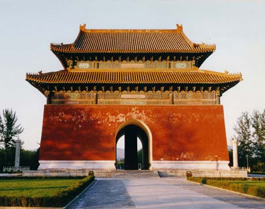
In China, monuments are first demolished and then rebuilt
 |
Authorities promise to restore the original appearance of the monumental arches originating from the Ming and Qing dynasties that delineated the wall demolished in the 1950s. This area is now part of the city outskirts and a subway line runs through it.
The landscape here has changed so much that many inhabitants of Beijing support this pharaonic project of "fake monuments" in the heart of a country that has been a master at the art of copying for centuries.
A typical example is the Qianmen district south of the Forbidden City. It was demolished during gigantic construction changes in the metropolis before the 2008 Olympic Games. It has been rebuilt in the style of some tourist-historical Disneyland, where people stroll among the neon advertisements of large international companies.
The neologism "Qianmenization" has since come to denote a common practice in communist China, where the past is leveled and then, as if in reproach, rebuilt with glazed tile roofs adorned with kitschy lanterns.
"It is an ignorant, foolish, and greedy practice. Ignorant because they do not realize the importance of cultural heritage; foolish because they do not understand the essential role of the old city for society; greedy because corruption seeps through every stage of reconstruction," argues He Shuchong, the founder of the Center for Cultural Heritage Protection.
Qianmenization now relates to areas in Beijing such as Nanluoguxiang, which has been bulldozed. Film set decorations have already been altered in other neighborhoods before this, states Hua Xinmin, author of a book titled "I Do Not Want to See My Homeland Disappear."
This activist has launched an uneven battle against builders and local communist officials who enrich themselves by demolishing old neighborhoods: they ruthlessly evict residents, who are often poorly compensated, and violate applicable laws.
"We need to better utilize funding to preserve what we have left, rather than rebuilding something that no longer exists,” says Hua Xinmin. She estimates that two-thirds of the old alleys in Beijing have already disappeared in this manner.
Hua Xinmin has strongly opposed the American weekly Time, which included the famous construction mogul Chen Lihua, who destroyed an old Beijing district, in its list of the hundred most influential people of 2012.
The scenario of evicting residents and demolitions affects all Chinese cities.
In the west of the country, in the city of Kasha on the former Silk Road, the historical center is being irretrievably destroyed, although there is protest from abroad as well. Traditional brick and plaster houses are being replaced by similar but new ones.
However, resistance to this practice is now being better organized, thanks to social networks. Ms. Hua's microblogs are followed by nearly 15,000 internet users.
The recent demolition of an ancient house belonging to a pair of renowned architects sparked a flood of furious reactions online. Liang Sicheng (1901-1972) and Lin Huiyin were ironically pioneers in the conservation of Chinese cultural heritage.
Today, it is not possible to penetrate the location where the supposedly protected residence stood. Builders are working in the area, access is blocked by guards, and a fence obstructs the view of curious onlookers.
Somewhat farther from the concrete kingdom, the former residence of Chiang Kai-shek in Chongqing city in southwestern China has fallen victim to "preventive demolition." After criticism, authorities timidly committed to rebuilding it.
The English translation is powered by AI tool. Switch to Czech to view the original text source.
2 comments
add comment
Subject
Author
Date
Je za tim Velka Cina?
takyarchitekt
09.05.12 01:17
Mizející hmotné kulturní dědictví
Jan Brejcha
09.05.12 08:21
show all comments











